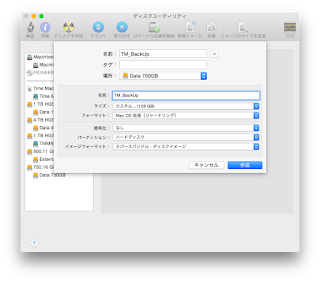
- #Chronosync sparse bundle install#
- #Chronosync sparse bundle upgrade#
- #Chronosync sparse bundle portable#
- #Chronosync sparse bundle software#
- #Chronosync sparse bundle mac#
These will also live in the cloud and are subject to the same potential fate mentioned above. Move them to a folder associated with the email address. These however, are tied to the cloud so if you stop that particular email account, you would eventually lose access to your inbox.ī. Leave them in the inbox which builds up over time obviously. When storing emails here are a few strategies.Ī. How can I prevent this from happening in the future? It was an old work account that I no longer have access to. I closed my email account and can no longer find my old emails. But hopefully those files are all in the correct place and everything should just work. If, for some reason, you open your Music application and see all your music but none of your playlists, you’ll need some assistance again. xml files and such need to be present and in the correct place in order for your old playlists to show up.

The music folder contains both music AND some important files that apple uses to build your playlists and other groupings. This will be the largest potential for problems from your data recovery.
#Chronosync sparse bundle upgrade#
The application should find the old files and upgrade those files to the new music library format.
#Chronosync sparse bundle mac#
Since you’ve not yet opened “Music” on your new Mac, just drags the old “iTunes” folder from your TM backup drive into the “Music” folder on your Mac and then open the new Music app. What do I need to look out for?Īs Apple has transitioned from using the word “iTunes” to instead using the obligatory term “Music” (way to go Apple) the folder names have changed slightly. I'm bringing my old iTunes music into my new computer from an old backup.
#Chronosync sparse bundle software#
The time machine software is very good and usually has no problem just picking right back up where it last left off with the backup. No need to worry if the electricity goes out. There are other ways to eject but these are the easiest two methods. The proper way to eject the drive is to either:Ī: drag the hard drive icon (usually olive green) to the trash which becomes an eject icon as soon as you start dragging it or…ī: right click the external hard drive icon and choose eject. The computer just prefers that you eject the drive properly. You really shouldn't even have to see that message. The box in the upper corner of the screen is a message the computer is displaying that is basically saying the drive accidentally disconnected. Really just at least every few days for it to have a chance to record all the things you've added to your computer within the last time. You don't need to keep your time machine backup drive connected ALL the time.
#Chronosync sparse bundle portable#
( Eject” Seagate Portable Drive” before disconnecting or turning off) Don’t I always keep the hard drive connected to my desk too? If I need to turn off my computer and then turn it back on for any reason, do I unplug the hard drive, then once computer is up and running again reconnect it? What happens of the electricity fails and the hard drive is connected…I would think it would be OK?Īlso I am traveling/flying in a couple of days….do I need to keep the hard drive connected to the lap top at all times? There are so many responses to backup requirements, but don't focus on the technology without answering the basic questions above ( and in my previous post ) I have seen this go wrong on so many occasions.Scotty….I have this box in upper corner of my deck top computer screen. ( Don't forget to store a copy of your backup application as well. How do you take your data off-site to securely store it ? It is easier to store tape media off-site than hard disks. To prevent the complete re-install of a Mac, SuperDuper! can help, because you can have bootable backups ( a clone ) of each Mac.
#Chronosync sparse bundle install#
TM backups are not bootable, so if one of your 8 Mac's fail on hardware, you are looking at a complete install of the OS and then restore data from TM. TM and TC are great tools and are automated, very useful to quickly restore a previous version of a file. )ĭ) know how much money your company wants to spend on backups.


( Hardware failure, data deletion, data corruption, theft, fire, a strike, the swine flu, a disgruntled sys admin. Ī) can restore the data within the agreed time frameī) can restore data with the agreed level of data loss.Ĭ) define the scenario's that are likely to make data not usable Ī backup solution is only successful if you. Take a step back and identify what exactly is your ' problem space '. TM, TC, SuperDuper! are just tools that you can use to address a specific issue. For your issue ( protecting the data of a small office ) I suggest not to jump on the technology immediately.


 0 kommentar(er)
0 kommentar(er)
